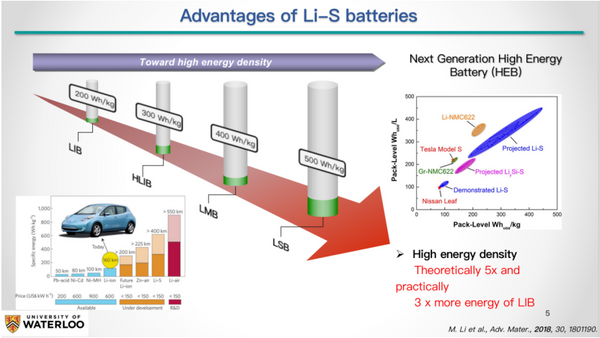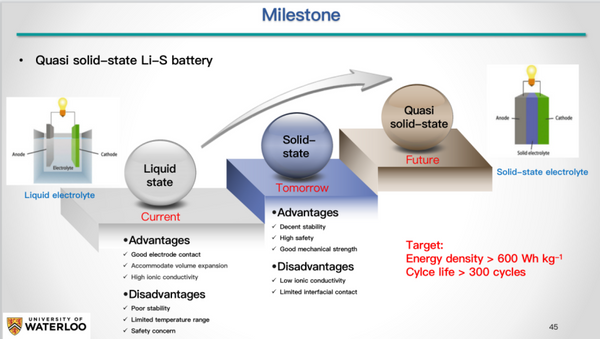The energy density of the battery is expected to reach 500Wh/kg in the future, so that the application of electric vehicles and other fields will be further expanded. Under the requirement of energy density, the current lithium electric energy can reach, for example, 200-300Wh/kg. With the development of lithium metal, the next generation will reach 400Wh/kg, and the weight energy density of lithium sulfur will reach 500Wh/kg. This is the future goal. This is also the advantage of lithium-sulfur batteries.
In addition to the energy density advantage of lithium-sulfur batteries, the cost advantage is very important, and the cost of sulfur is still very cheap. With the advantages of energy density and cost, the scientific research community of lithium-sulfur batteries has done a lot. As far as lithium-sulfur batteries are concerned, the biggest challenge is the shuttle effect of lithium polysulfides. After the shuttle passes, the cycle stability is relatively poor, so the problem to be solved by lithium-sulfur batteries is cycle life. As far as the cycle life is concerned, there are several lithium-sulfur battery companies in the United States. The batteries they are doing close to commercial testing are basically 300-400Wh/kg, but their lifespan is very low, basically no more than 100 cycle, compared with the life of lithium-ion batteries, the gap is large.

In the bifunctional sulfur catalytic system, our goal is to control the path of the reaction and further improve the stability. In fact, directional catalysis is introduced, that is, the two different active sites mentioned above play different roles. This is our Purpose.
This is a material that incorporates a metal composite, which has a bifunctional effect. Recently, MOF and COF materials have been introduced as composite sulfur cathode materials.
These are the work of cathode materials, and we hope to solve them by: increasing the specific surface area and the number of active sites; by improving the reaction kinetics that promotes it; and better controlling the selectivity of reaction products.
The second job is the separator. We hope that the separator can serve three purposes: block sulfur, accelerate the conversion reaction of lithium polysulfide, and achieve rapid conduction of lithium ions. This work started in 2017. We also integrated the control of the reaction of the cathode material into the separator, because the comprehensive integration effect of the separator improves the cycle life and prevents the shuttle of sulfur, because the shuttle of sulfur mainly affects the life.
At the same time, we tried different materials, such as graphene oxide composited with defective antimony selenide nanorods. On this basis, other MOF materials were directly grown on the separator. We found that this effect was very obvious, because MOF itself hindered Sulfur effect is very obvious. On this basis, we introduce the goal of organic functionalization, and put a layer of amphoteric polyionic liquid on the diaphragm, which has a good sulfur blocking effect.
On the basis of the separator, we have begun to make lithium metal negative electrodes. Li metal is not only useful for lithium-sulfur batteries, but also very important for future lithium metal batteries. Our group's work on lithium metal is mainly through the design of the lithium metal support structure, and the other is to control the growth of SEI to prevent the growth of lithium dendrites. In fact, we have been doing this work for several years, mainly to construct lithium metal artificial SEI, and to improve the lithium metal carrier at the same time. We combine porous materials with artificial SEI, hoping that lithium metal growth will not generate lithium dendrites.
This is a lithium metal carrier designed by spray drying method. We found that the stability is still very high. At the same time, we are now doing the regulation of SEI, mainly by in situ growth of SEI on the surface of lithium metal during the electrochemical process. In situ SEI can effectively inhibit the growth of dendrites, which can play a very good role in application and is also a relatively simple method.
On this basis, we found that controlling the composition of the electrolyte can also control the growth of SEI, which can play a good goal of inhibiting the growth of lithium dendrites. On this basis, we also introduced a solid electrolyte, which we found in the lithium-sulfur battery can indeed improve the stability and life. When we do it, the solid electrolyte will also introduce a certain liquid electrolyte. In fact, the better effect is the semi-solid state.
This is based on our work on lithium metal, and we hope to improve the life of lithium-sulfur batteries. We made some larger batteries. We started to make the height of 6 mAh/cm2, and then made lithium-sulfur batteries with energy density of 490 Wh/kg, but the cycle life was relatively poor, and we could only do 20 cycles or so. In the future, it is hoped to further improve the cycle stability of the battery through the combined use of a new process of electrolyte and lithium metal.
We made the electrolyte system from liquid to solid, and now we start to make semi-solid, I think the effect of semi-solid is the most ideal. Our goal is to achieve more than 500Wh/kg in the future, and the cycle target is more than 300 laps. There is still application prospect in some markets.

